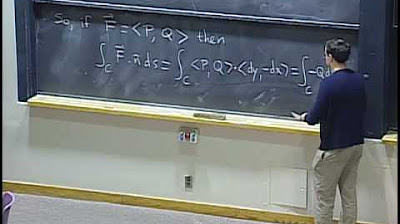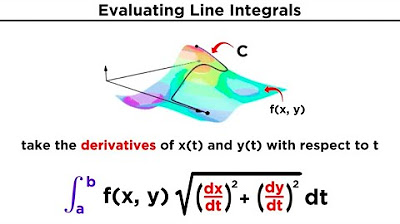Conceptual clarification for 2D divergence theorem | Multivariable Calculus | Khan Academy
TLDRThe video script delves into the concept of line integrals, emphasizing the need for precision and unit consistency. It clarifies the role of F as a vector function representing mass density and velocity, and how it relates to the rate of mass flux across a boundary. The script uses the path 'C' and the unit normal vector 'n' to illustrate the computation of the line integral F.n ds, which quantifies the mass exiting the curve per second. The explanation incorporates dimensional analysis to ensure understanding of the units involved, ultimately aiming to provide a clear picture of how the integral represents the mass flow rate.
Takeaways
- 📌 The line integral F.n ds is revisited for a more precise understanding with units.
- 📈 F is described as a vector field representing mass density (Rho) and velocity (M and N) at any point in the x-y plane.
- 🌀 The concept of velocity is corrected to include a density aspect, making F a product of a scalar function (mass density) and a vector function (velocity).
- 🔢 Mass density (Rho) is represented by the Greek letter rho and is measured in kilograms per square meter in the given example.
- 🏃 Velocity components M and N are scalar functions with units of meters per second, indicating speed in the i and j directions respectively.
- 🔽 The unit normal vector n represents the direction perpendicular to the curve at any given point.
- 🤝 The dot product F.n gives the component of F in the direction of n, which is the normal to the curve.
- 📐 The units of F.n are kilograms per meter second, representing the magnitude of the vector in the normal direction.
- 🔄 The line integral F.n ds represents the rate of mass crossing a small segment of the curve per second, with units of kilograms per second.
- 🔍 The integral is analogous to the 2-dimensional divergence theorem, equating the line integral to the double integral of the divergence of F over the enclosed area.
- 🧠 The script emphasizes the importance of understanding the conceptual representation of the vector function F for a better grasp of mathematical concepts.
Q & A
What is the line integral F.n ds?
-The line integral F.n ds represents the concept of flux through a boundary, specifically the rate of mass exiting a certain boundary. It involves integrating the dot product of a vector field F and the unit normal vector n along a curve C.
How does the video correct the previous explanation of F as a velocity function?
-The video corrects the previous explanation by introducing a density aspect to F. Instead of just considering F as a velocity function, it is now represented as a product of a scalar function (mass density) and a vector function (velocity vector), which together provide a more accurate representation of the mass flow rate.
What is the significance of the unit normal vector n in the line integral?
-The unit normal vector n at any point on the curve is significant because it specifies the direction that is perpendicular to the curve at that point. When taking the dot product with F, it gives the component of F that is in the direction of the normal, which is essential in determining the rate of mass flow across the boundary defined by the curve.
What units are associated with the scalar function Rho in the context of the line integral?
-In the context of the line integral, the scalar function Rho represents mass density and is associated with units such as kilograms per square meter (kg/m^2), which represents mass per unit area.
What units are associated with the vector components M and N in the line integral?
-The vector components M and N represent the velocity of particles at a point and are associated with units of distance per time, such as meters per second (m/s).
What does the dot product F.n yield in terms of units?
-The dot product F.n yields a quantity with units of kilograms per meter second (kg/m*s), which represents the magnitude of the mass flow rate in the direction of the unit normal vector n.
How is the line integral F.n ds related to the integral of the divergence of F over an area?
-The line integral F.n ds is equivalent to the double integral of the divergence of F over the area enclosed by the curve C. This relationship is similar to the 2-dimensional divergence theorem and allows for calculating the total mass exiting the boundary per second by summing up the mass flow rates across infinitesimally small segments of the curve.
What are the units of the double integral over the area of the divergence of F?
-The units of the double integral over the area of the divergence of F are kilograms per second (kg/s), which represents the total mass flow rate across the entire area enclosed by the curve C.
How does the concept of mass density and velocity contribute to understanding the line integral?
-The concept of mass density and velocity contributes to understanding the line integral by providing a more comprehensive representation of the physical quantities involved. Mass density (Rho) gives the amount of mass per unit area, and the velocity vector (M and N components) describes the speed and direction of particle movement. Together, they allow for the calculation of the mass flow rate across a boundary, which is the essence of the line integral F.n ds.
What is the significance of the units in the context of the line integral?
-The units are significant as they provide a physical interpretation of the line integral. By ensuring that the units are consistent and make sense physically, we can confirm that the mathematical operations and the resulting quantities are meaningful and correctly represent the physical situation being modeled.
How does the video script help in developing a stronger conception of the vector function F?
-The video script helps in developing a stronger conception of the vector function F by breaking down its components and explaining their physical significance. By relating F to mass density and velocity, and walking through the units and mathematical operations involved, the script provides a clear and detailed understanding of what F represents in the context of the line integral and mass flow.
Outlines
📏 Understanding Line Integral with Mass Density
This paragraph delves into the concept of line integral, emphasizing the importance of precision and unit usage for a comprehensive understanding. It introduces the path 'C' traversed in a positive counterclockwise direction and discusses the 2-dimensional vector F at various points in the x-y plane. The unit normal vector 'n' at any point on the curve is also explained. The paragraph corrects a previous imprecise description of F as a velocity function, instead proposing a new representation of F as a product of a scalar function (mass density 'Rho') and a vector function (velocity vector). The units for these functions are also discussed, with 'Rho' in kilograms per square meter and the velocity vector in meters per second. The paragraph concludes by explaining how the line integral F.n ds represents the rate of mass exiting the boundary per second, with the final integral expressing the total mass exiting the curve.
🔢 Analyzing the Dot Product and Units in Line Integral
The second paragraph continues the discussion on line integral by focusing on the dot product operation, which quantifies the magnitude of the vector F in the direction of the normal vector 'N'. It explains the units of the dot product, which are kilograms per meter second, and how these units are derived from the product of the mass density function and the velocity vector components. The paragraph then introduces the concept of integrating this quantity over an infinitesimally small segment 'ds' of the curve, leading to the units of kilograms per second. This represents the rate of mass crossing a section of the curve per second. The paragraph further connects the line integral to the double integral over the area of the divergence of F, explaining the units of the divergence components and how they contribute to the overall integral, which is again in kilograms per second, indicating the total mass flow rate across the entire area.
Mindmap
Keywords
💡Line Integral
💡Vector Field
💡Mass Density
💡Unit Normal Vector
💡Dot Product
💡Divergence Theorem
💡Divergence
💡Partial Derivative
💡Double Integral
💡Mass Flow Rate
💡Units of Measurement
Highlights
Revisiting the line integral F.n ds for a better understanding of its concept and application.
The introduction of units in the line integral to enhance comprehension of the physical quantities involved.
Description of F as a 2-dimensional vector field representing a velocity function at any point in the x-y plane.
Clarification that F should be viewed as a flux through the boundary, representing the rate of mass exiting the boundary.
The necessity to introduce a density aspect to F, represented by the scalar function Rho (ρ) for mass density.
Explanation of Rho as mass per area in a 2-dimensional world, with units of kilogram per square meter.
The vector function representing the velocity of particles at a point, with components M(x,y) and N(x,y) in units of meters per second.
The calculation of the units for the vector F as a product of scalar and vector functions, resulting in kilograms per meter second.
The dot product of F and the unit normal vector N, which gives the magnitude of F in the direction of N.
Integration of the line integral F.n ds to determine the mass crossing a section of the curve per second, with units of kilograms per second.
The integral F.n ds is equivalent to the double integral over the area of the divergence of F, relating to the 2-dimensional divergence theorem.
Calculation of the divergence of F involving the partial derivatives of the components Rho M and Rho N with respect to x and y.
The units of the double integral's components being kilograms per meter second per second, derived from taking derivatives with respect to distance.
The summation of kilograms per second throughout the entire area, providing a total mass exiting the curve per second.
The importance of understanding the vector function F in the context of mass flow and its physical interpretation.
The suggestion to ignore the vector function F if it causes confusion, aiming for a clearer conception of its representation.
Transcripts
Browse More Related Video

Conceptual understanding of flux in three dimensions | Multivariable Calculus | Khan Academy

Lec 23: Flux; normal form of Green's theorem | MIT 18.02 Multivariable Calculus, Fall 2007

Evaluating Surface Integrals

Evaluating Line Integrals

2D divergence theorem | Line integrals and Green's theorem | Multivariable Calculus | Khan Academy

Stokes' theorem proof part 4 | Multivariable Calculus | Khan Academy
5.0 / 5 (0 votes)
Thanks for rating: